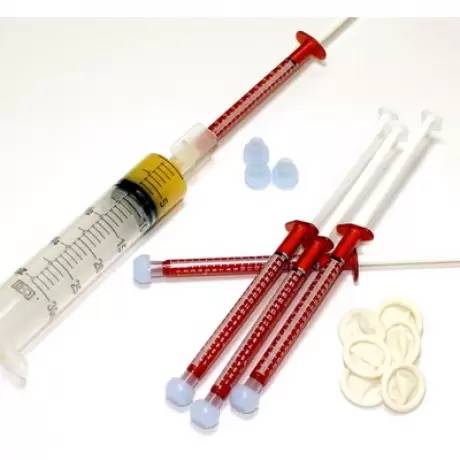
Amitriptyline Transdermal Gel (Compounded) Rx
Amitriptyline Transdermal Gel (Compounded) Rx
Amitriptyline Transdermal Gel (Compounded) is currently unavailable.
Please check back with us at another time as we are uncertain when we will have more in stock.
What is Amitriptyline Transdermal Gel for Dogs and Cats?
- Amitriptyline is a prescription anti-depressant drug called a tricyclic, that affects certain chemicals in the brain that are unbalanced.
- It it used to control behavior problems in dogs and cats such as anxiety, separation anxiety, excessive grooming, and urine spraying in cats.
- It is also used in the treatment of chronic nerve pain and severe itching.
- Amitriptyline transdermal gel is applied topically to a hairless portion of the skin, typically the inner side of the ear lobe, where it absorbs through the skin into the bloodstream.
- Transdermal gels are suggested for dogs and cats who will not take medications by mouth.
Why do cats and dogs use Amitriptyline?
- Amitriptyline is a medication used treat behavioral problems or nerve pain in dogs and cats.
- If your pet has been diagnosed with a behavior disorder your veterinarian may prescribe an antidepressant medication like Amitriptyline.
What else should I know about Amitriptyline?
- Protective finger cots or examination gloves should be worn when applying transdermal gels.
- It may take several days or weeks to determine if Amitriptyline is effective.
- Make sure your dog or cat has plenty of fresh water to drink.
What problems could my dog or cat have with Amitriptyline?
- Common side effects are sleepiness, dry mouth, and constipation.
- It is important to NOT use a flea collar while giving Amitriptyline without talking to your veterinarian first.
- Rare but serious side effects include bleeding, fever, seizures, or rapid/ irregular heartrate. Contact your veterinarian immediately if you notice any concerns.
- Overdoses of Amitriptyline can be very serious. Keep Amitriptyline out of the reach of children and other animals.
How do you use Amitriptyline?
- Apply the Amitriptyline transdermal gel to the hairless portion of the inner ear as directed by your veterinarian.
- Always finger cots or examination gloves when applying the gel to protect yourself.
What is in Amitriptyline?
- Amitriptyline is a prescription anti-depressant drug called a tricyclic antidepressent.
- Amitriptyline affects certain chemicals in the brain that are unbalanced.
Will I get what I see in the picture?
- Amitriptyline Transdermal Gel is a compounded medication. The ingredients will be mixed specially for your dog or cat in our pharmacy.
Is it important for my dog or cat to finish all of the Amitriptyline?
- Dogs and cats may use this product for different lengths of time. Please consult your veterinarian if you have any questions.
Who makes the Amitriptyline Transdermal Gel?
- The Amitriptyline Transdermal Gel is hand-made in our pharmacy.
- There is a minimum charge of $59.99.
- Shelf-life limits orders to a 20-day supply.
Review Summary
11 total reviews
Rated 4.64 out of 5 stars
100% of respondents would recommend this to a friend
Ratings Distribution
9 5 star reviews
1 4 star reviews
0 3 star reviews
1 2 star reviews
0 1 star reviews
Most Liked Positive Review
Best Way to Give Meds to a Difficult Cat
I call my cat "Crazy Louie" for a reason, but his anxiety had gotten out of control. When the vet prescribed amitriptyline for him I knew there was no way I could give him a pill daily. A little internet research brought me to vetrxdirect. They were great in getting the info from my vet and the customer service is excellent. Giving Louie his medicine this way is a breeze. Ordering refills is super easy. And I'm happy to report that the medicine has been a miracle for my "special needs" kitty - he is doing SO MUCH better!
Most Liked Negative Review
Maybe
The is OK and I appreciate the finger cots and cat treats alot. My problem is the cream medium you use. It cakes onto my cat's ears and I have to constantly clean his ears-which he hates. My local compounding pharmacy used a white cream medium which seemed to absorb in his much better.
Reviews
-
I won't use any other pet pharmacy
From UndisclosedComments about Amitriptyline Transdermal Gel (Compounded)My cat MatchkeBaby developed an anxiety after our German Shepherd died .. that also led to urinary crystals and self destructive behavior ( he licked his penis bloody) .. our veterinarian suggested Amitriptyline.. we tried pills - it was stressing out not just my cat but also us - the cat parents . Then I ordered the medication in a liquid ( chicken flavor) from petmeds - the price was reasonable- unfortunately the medication caused my boy to foam at a mouth and vomit . Then the vet suggested Amitriptyline in a form of a gel to be applied to the skin inside cats' ears . That sounded awesome ! We live in nyc and a monthly supply of the medication was $75 !so expensive.. with other cats and foster kittens to take care of we were struggling.. then by miracle I found VETRXDIRECT! what an amazing company. 1. The price is low!2.the customer service is outstanding !3. The ordering process is easy and fast and so is the delivery . 4.the gel is thicker to compare to the one we used before and therefore it's easier to apply and doesn't slip off the finger - so no waste ! 5. The kitty likes it better too and had no side effects. I will order again and again. I will also order some eye drops and other supplies in the near future. -
-
Experienced drug packager gives these a A+++++!
From UndisclosedComments about Amitriptyline Transdermal Gel (Compounded)I packaged drugs that were not unit-dosed or weren't in the required dose for pediatrics in a hospital in-patient setting for ten years. These are top of the line. I know what I'm talking about. -
Maybe
From undisclosedComments about Amitriptyline Transdermal Gel (Compounded)The is OK and I appreciate the finger cots and cat treats alot. My problem is the cream medium you use. It cakes onto my cat's ears and I have to constantly clean his ears-which he hates. My local compounding pharmacy used a white cream medium which seemed to absorb in his much better. -
Extremely successful and effective
From undisclosedComments about Amitriptyline Transdermal Gel (Compounded)We are transitioning a stray outdoor adult cat to the indoors. This medication was extremely easy to administer in gel form, as I am reluctant to put my fingers in his mouth to give him a pill. I can adjust the amount applied very easily. It has worked wonders and it looks like he will be happy indoors. Highly recommended! -
The only prescription that worked for my tuxedo kitty
From undisclosedComments about Amitriptyline Transdermal Gel (Compounded)Love this stuff. I was not able to dose my cat with the chicken flavored compound (he was having none of it), but getting an ear massage? Not a problem. He has had about 12 doses thus far, and seems to be responding well. His anxiety and aggression around the other cats has dissipated, and I'm praying it will stop his inappropriate urination issue. If this is being prescribed for your cat, I definitely recommend using the transdermal gel. -
-
Works great price was better then other sources
From Manitowoc WIComments about Amitriptyline Transdermal Gel (Compounded)Wash ears out with cloth apply in opposite ear daily. -
Overall they do a good job
From Parrish, FlComments about Amitriptyline Transdermal Gel (Compounded)Great customer service and prompt shipping however sometimes the compound in the syringe is not evenly distributed. -
Best Way to Give Meds to a Difficult Cat
From Buffalo, NY, USAComments about Amitriptyline Transdermal Gel (Compounded)I call my cat "Crazy Louie" for a reason, but his anxiety had gotten out of control. When the vet prescribed amitriptyline for him I knew there was no way I could give him a pill daily. A little internet research brought me to vetrxdirect. They were great in getting the info from my vet and the customer service is excellent. Giving Louie his medicine this way is a breeze. Ordering refills is super easy. And I'm happy to report that the medicine has been a miracle for my "special needs" kitty - he is doing SO MUCH better!-
![Best Way to Give Meds to a Difficult Cat]()
Just Relaxing
-
-
Trandermal med
From Charlotte, NC, USAComments about Amitriptyline Transdermal Gel (Compounded)My 12 yr old rescue kitty Reese does not take pills well and transdermal route keeps her stress level down for recurring interstitial cystitis. -
Very accomdating
From Florida, USAComments about Amitriptyline Transdermal Gel (Compounded)Although it is impossible to comment whether the mixture they put together is as it should be they do get things do quickly and efficiently. They contact the Vet quickly to get things started. Takes them awhile to find the Vet's fax so they can proceed.
Displaying Reviews 1 - 10
Q & A
-
My cat is using the transdermal gel ....my other cat is grooming his ear ...will anything happen if my cat licks the transdermal gel and ingests it ? Even hours later ? thank you?
-
The Amitriptyline Transdermal Gel should be rubbed into the hairless portion of your cat’s ear until there is minimal residue. After application, care should be taken that people or other animals do not come into contact with your cat for 2 hours. Please contact your veterinarian regarding any further questions or concerns about the use of this medication in your cat.
Verified Answer
-
-
What is this product compounded with to make it a transdermal gel??
-
Currently (11/5/2019), VetRxDirect uses a PLO (pluronic lecithin organogel) gel base to compound Amitriptyline transdermal gel.
Verified Answer
-
-
How well does this work on cats how long will I see improvements?
-
Amitriptyline Transdermal Gel is a prescription medication used to treat behavioral conditions. Transdermal gels may be considered an option if owners cannot get their pets to take an oral medication. Your veterinarian may also choose a different drug instead of using a transdermal compounded medication depending upon their preference and experience. Amitriptyline may take several days to weeks for the full effect of the drug to be seen. This drug affects every animal slightly differently, so it is not possible to be certain exactly what the effect will be, how long it will take to see a change, and how long the improvements will last. Please consult your veterinarian regarding any further questions or concerns regarding this medication in your cat.
Verified Answer
-
-
Do you need a prescription from vet go order this medication for our cat.??
-
Yes, a prescription is required from your veterinarian for Amitriptyline Transdermal Gel as it is a prescription product.
Verified Answer
-
-
Can transdermal amitriptyline gel cause vomiting in cats??
-
How many days are in one $6 syringe??
-
Amitriptyline gel comes in 1mL syringes. The number of days that each syringe will last depend on how much and how often your veterinarian prescribes. A typical dose is 0.1mL, which would equal 10 doses in a 1ml syringe.
Verified Answer
-
-
How many doses are there per prescription??
-
Amitriptyline gel comes in 1mL syringes. The number of doses that you will get from each syringe will depend on how much your veterinarian prescribes. A typical dose is 0.1mL, which would equal 10 doses in a 1ml syringe.
Verified Answer
-
-
After applying this to our cat's ear for several days, there is a residue that builds up in his ear. What is the best method to remove it??
-
You may use a wet washcloth to wipe the inner ear clean. After repeated dosing, you may see a small amount of dried residual gel that becomes noticeable. It should not be necessary to clean the inner ear after each application. This medication should be rubbed in well completely, leaving no visible excess gel on the skin. Any excess visible gel will dry and not be fully absorbed.
Verified Answer
-
-
I have read patient reviews on this product and have tried to find information as to HOW this medication is administered. Does one try to put the syringe into the cat's mouth? If it is administered 'trans-dermally', exactly where would this gel be administered. I have gone to several veterinary sites that sell this transermal gel but nowhere are there instructions posted as to how to administer. I have a prescription from my vet. My cat is pulling his hair out in clumps. Help!?
-
Transdermal gels are normally applied to the hairless skin of your cat's inner ear and rubbed in completely, leaving no visible excess gel on the skin.This medication absorbs through the skin and into the bloodstream to take effect, so gloves or finger cots should be worn by the person applying the medication to avoid personal exposure.
Verified Answer
-
-
Over time we notice that the compound builds up in our cat's ear. We have removed it with a washcloth and warm water but the water doesn't soften the buildup very quickly so it's a long process that our cat 'endures'. Do you have any suggestions as to how to clean his ears of this compound more effectively??
-
The best place to administer amitriptyline transdermal gel is to a place with minimal hair, typically the inner side of the ear lobe, in order to avoid build up of the medication. Usually the best way to remove any buildup is to remove it with warm water and a washcloth to soften the build up. Since this hasn't worked you could try mild soap and water as well to clean up the area. If this does not work It would be important to contact your pet's veterinarian to determine what might be the best product to remove the build up.
Verified Answer
-
Displaying Questions 1 - 10






